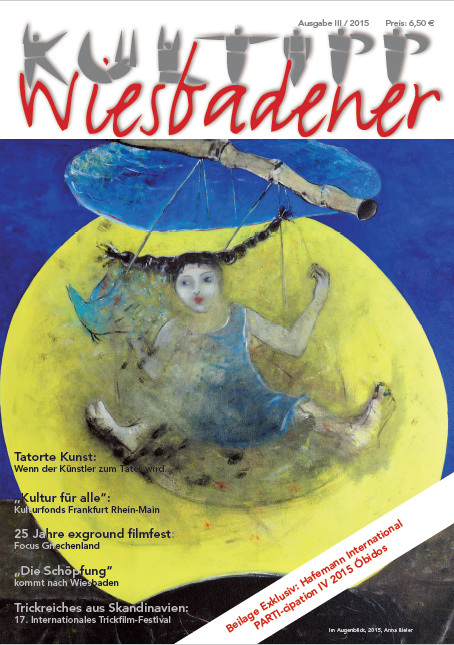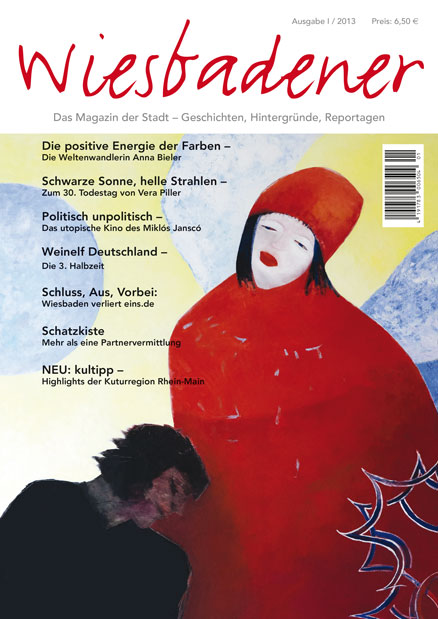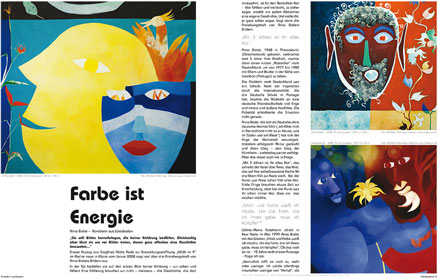



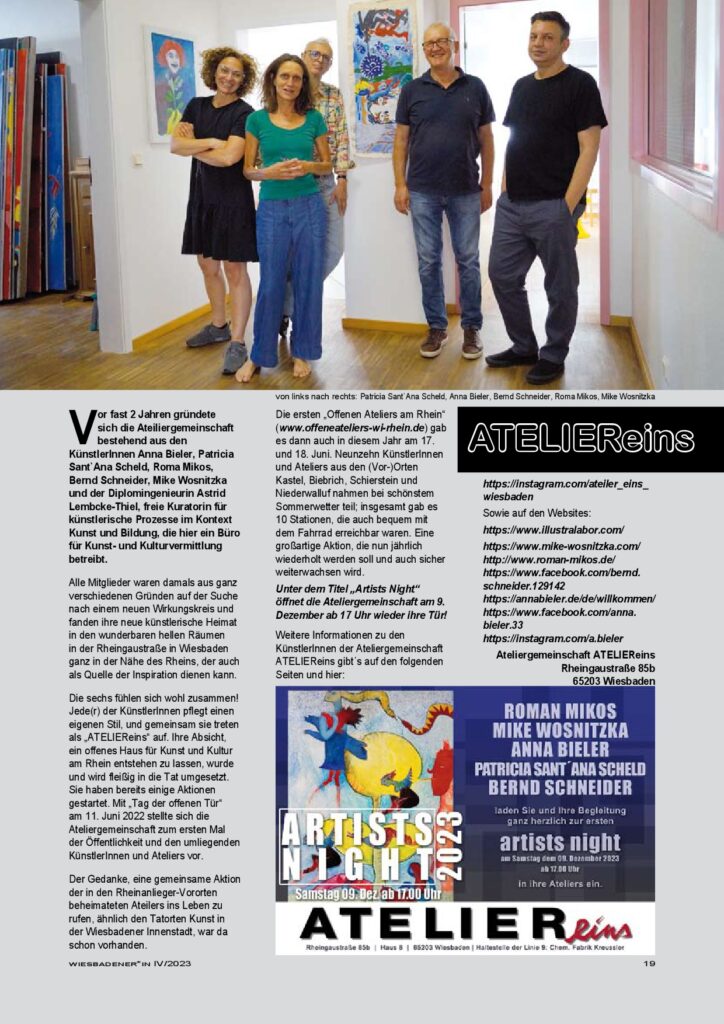
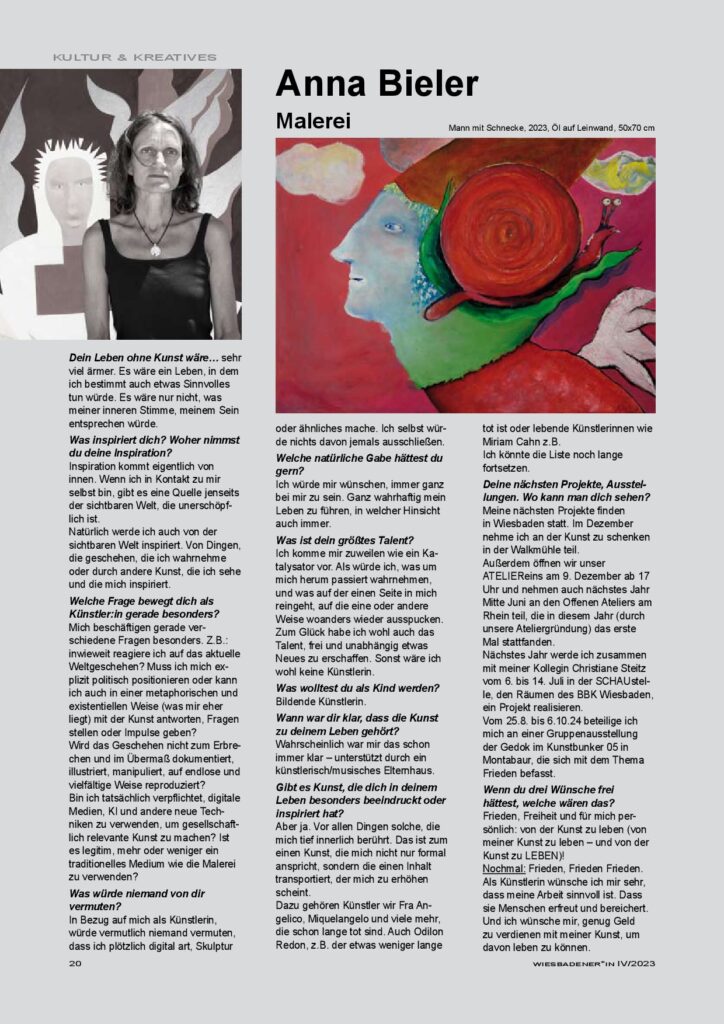
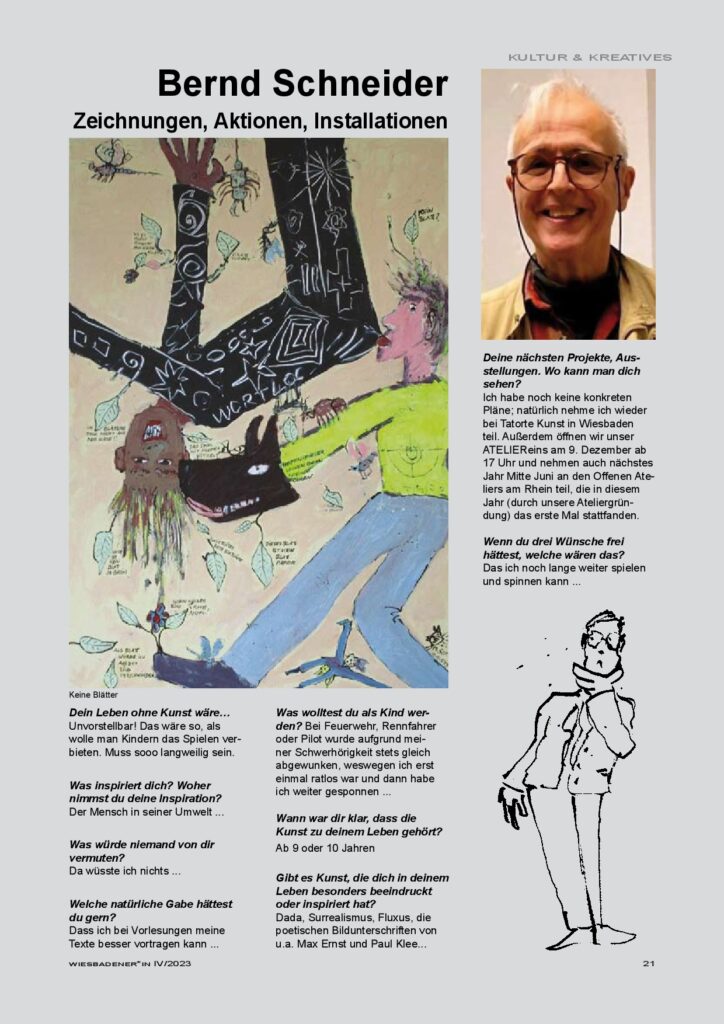
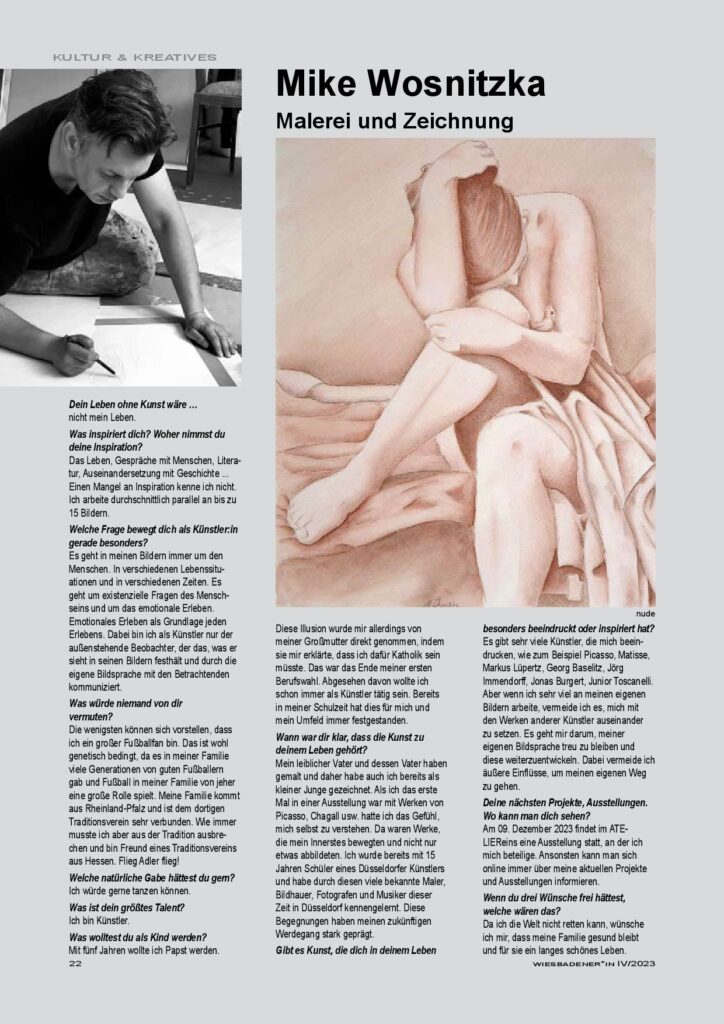

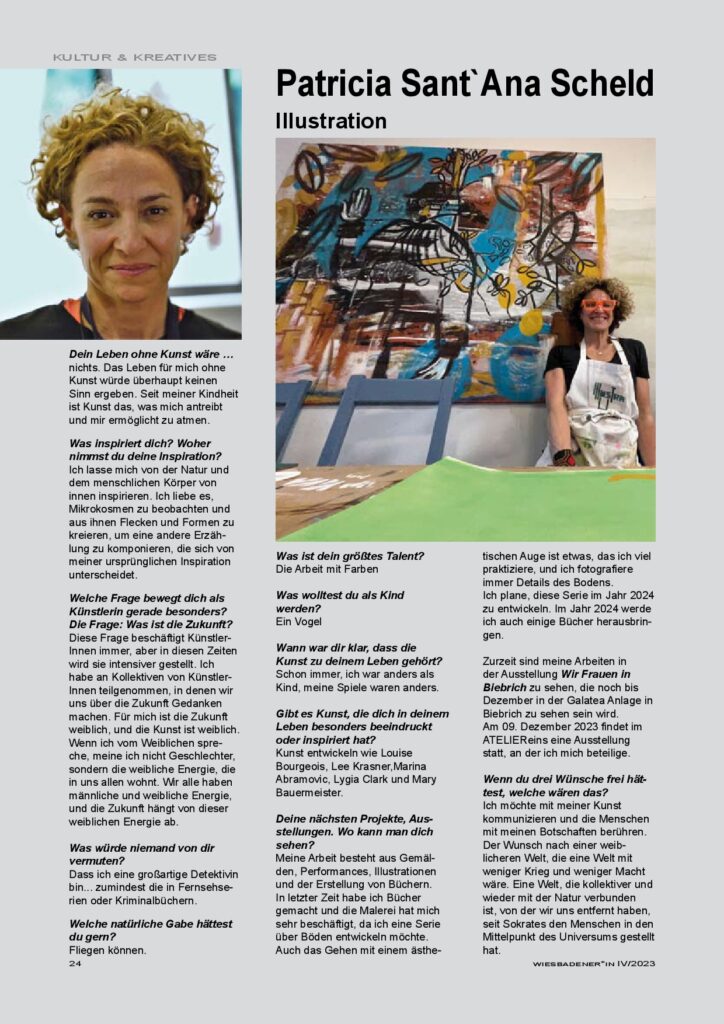

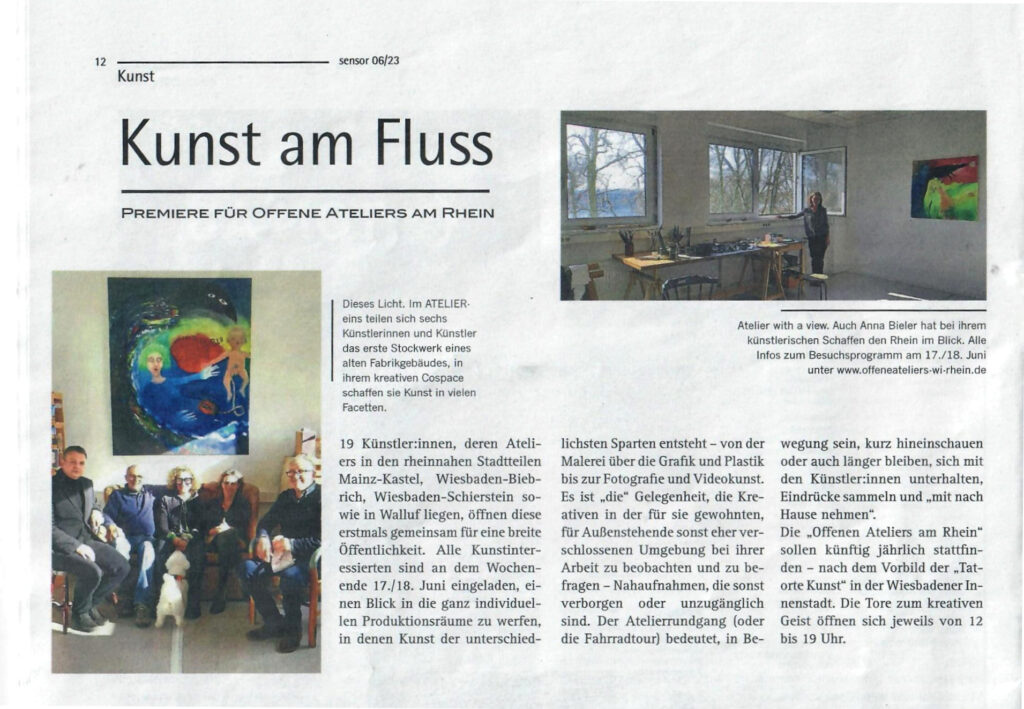
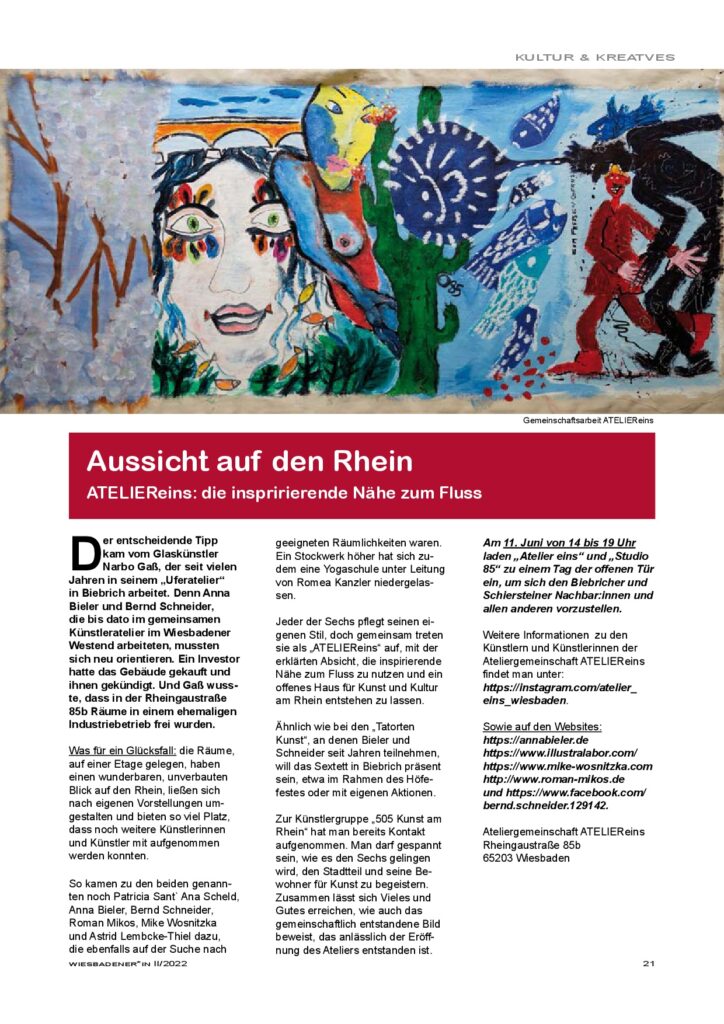
https://issuu.com/petraesser/docs/wbn0222web

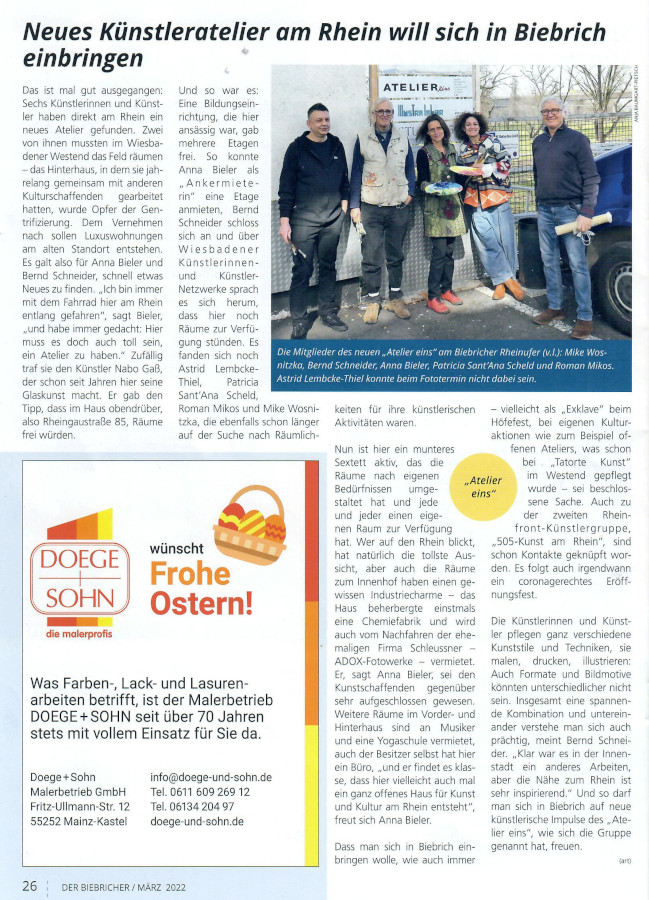
https://www.yumpu.com/kiosk/biebricher/der-biebricher-nr-364-marz-2022

https://www.dekanat-wiesbaden.de/angebote/bildung.html
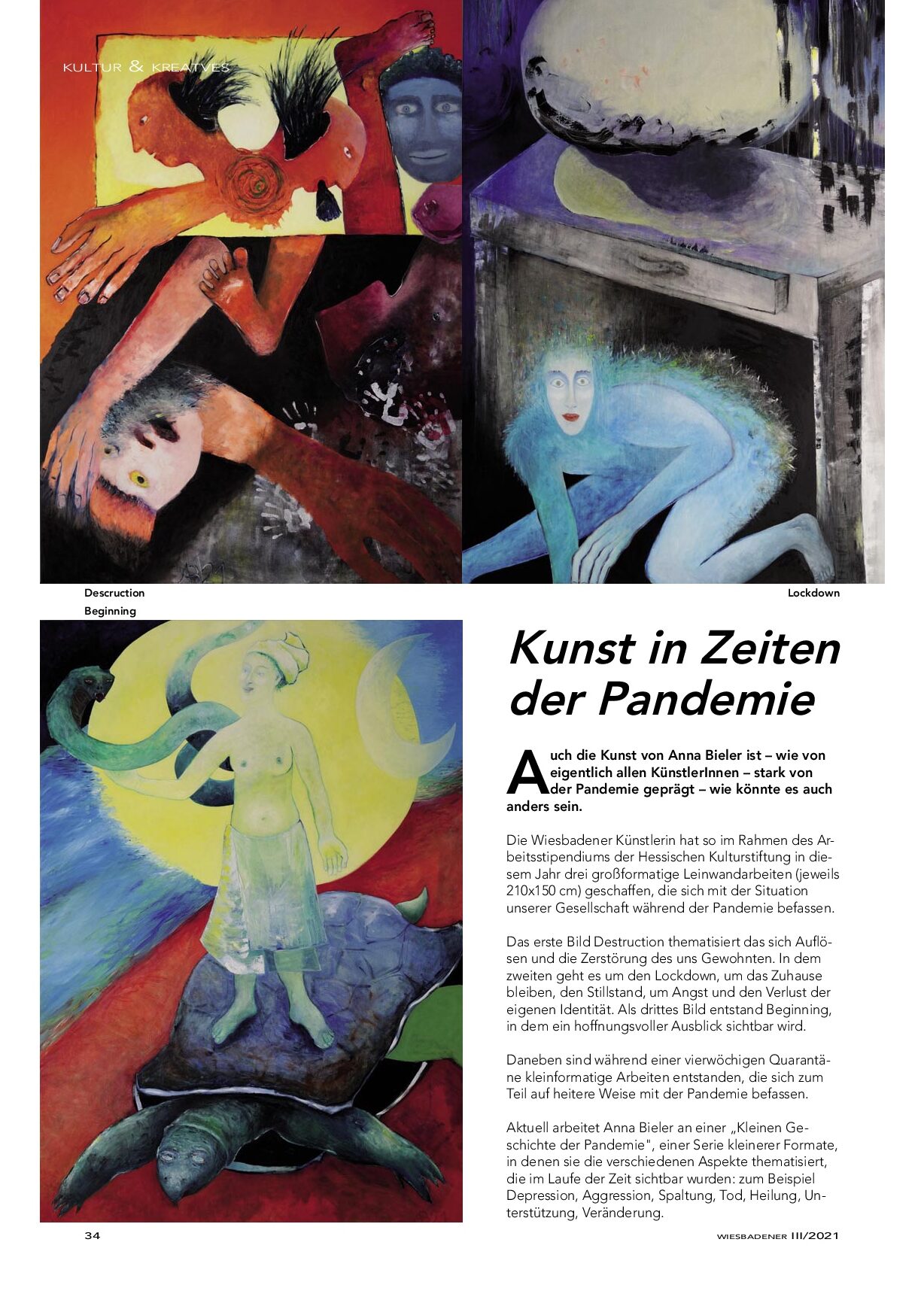
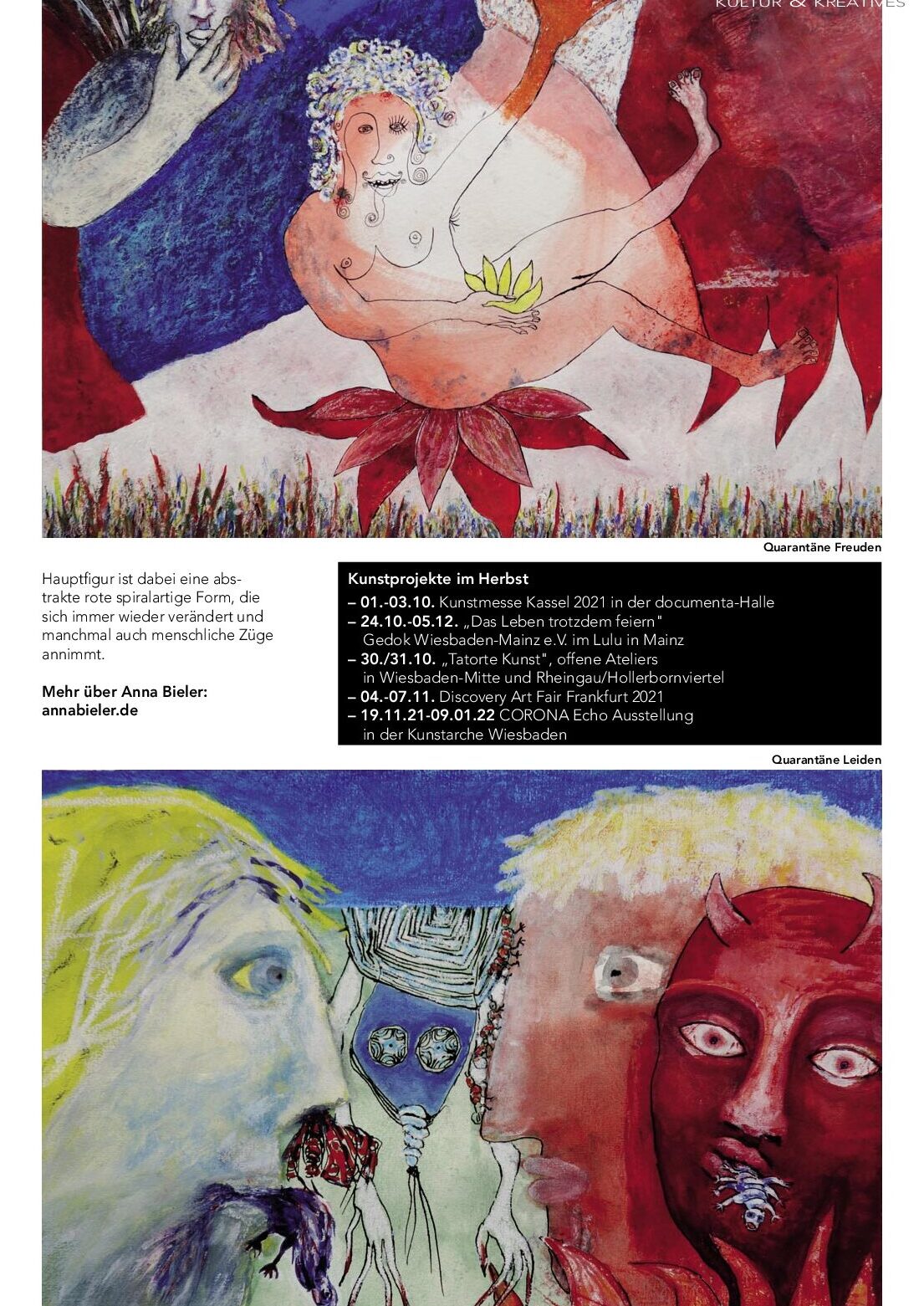
https://issuu.com/petraesser/docs/wbn0321web/s/13242680
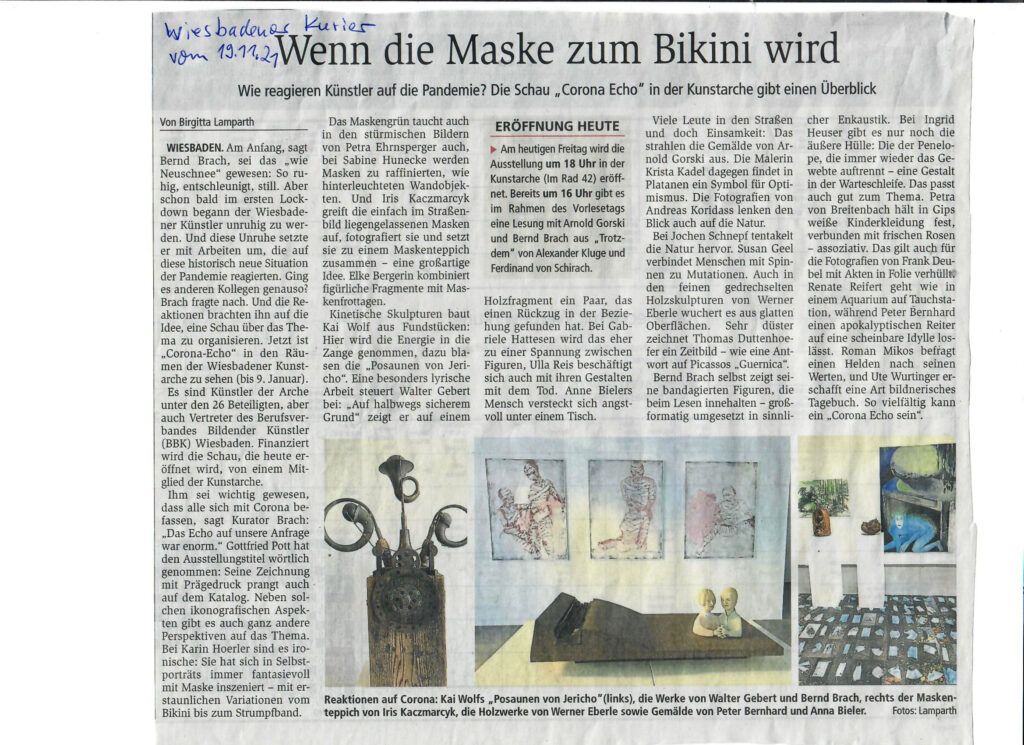
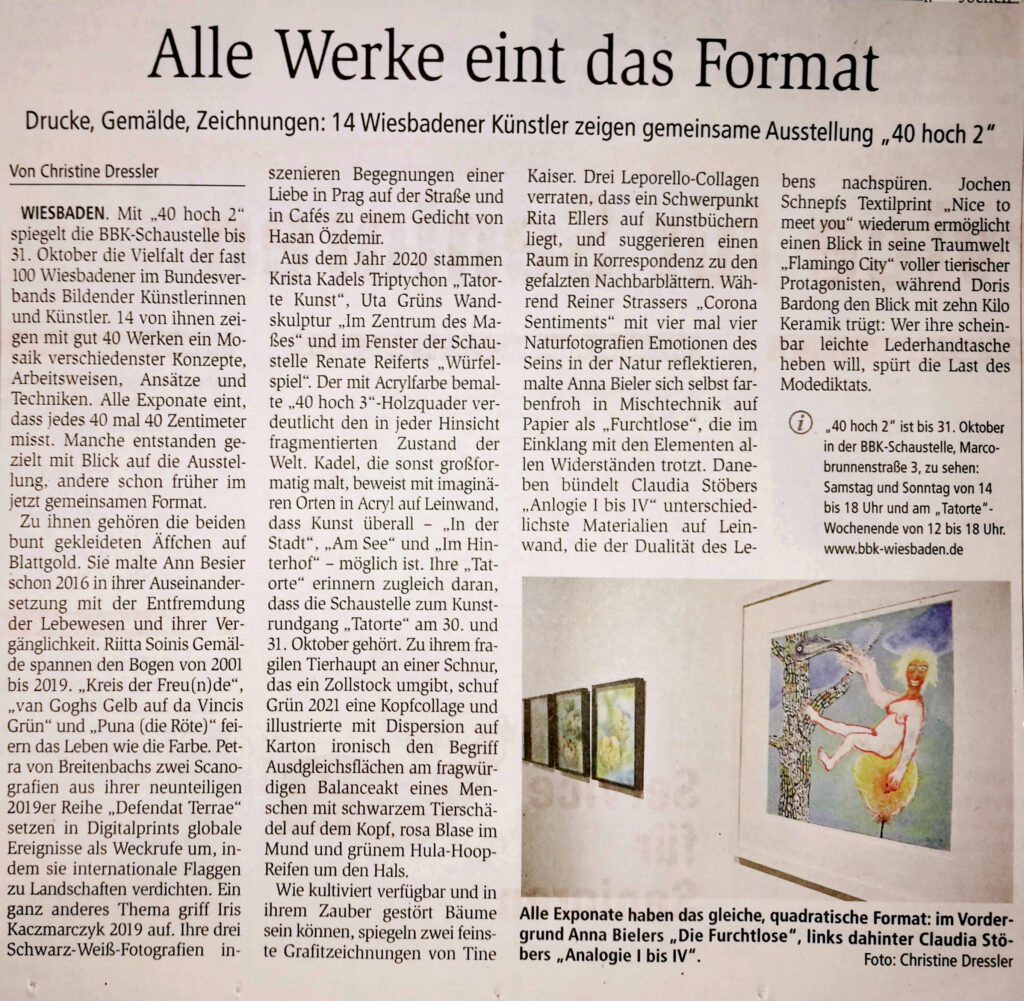
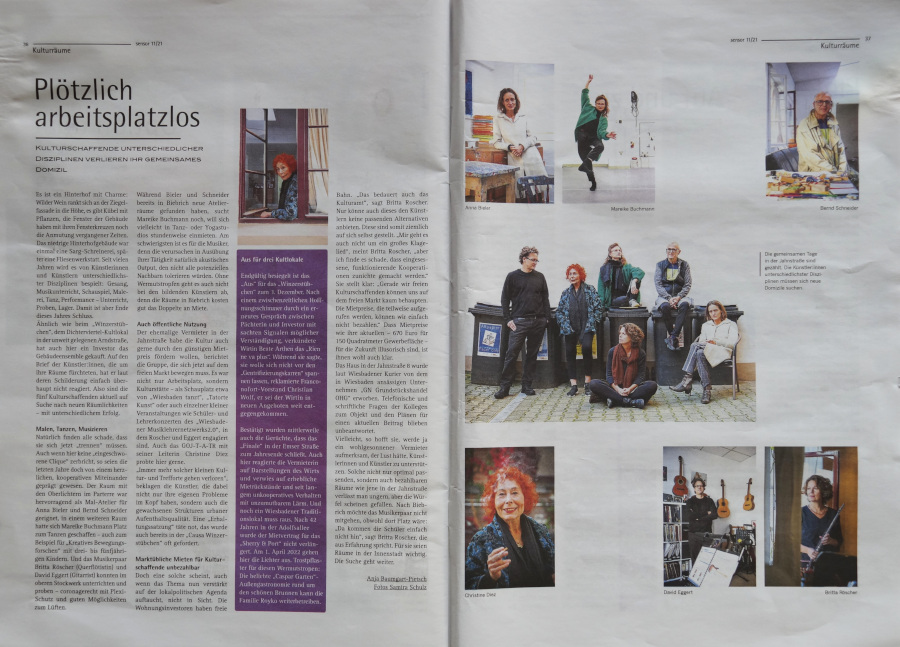

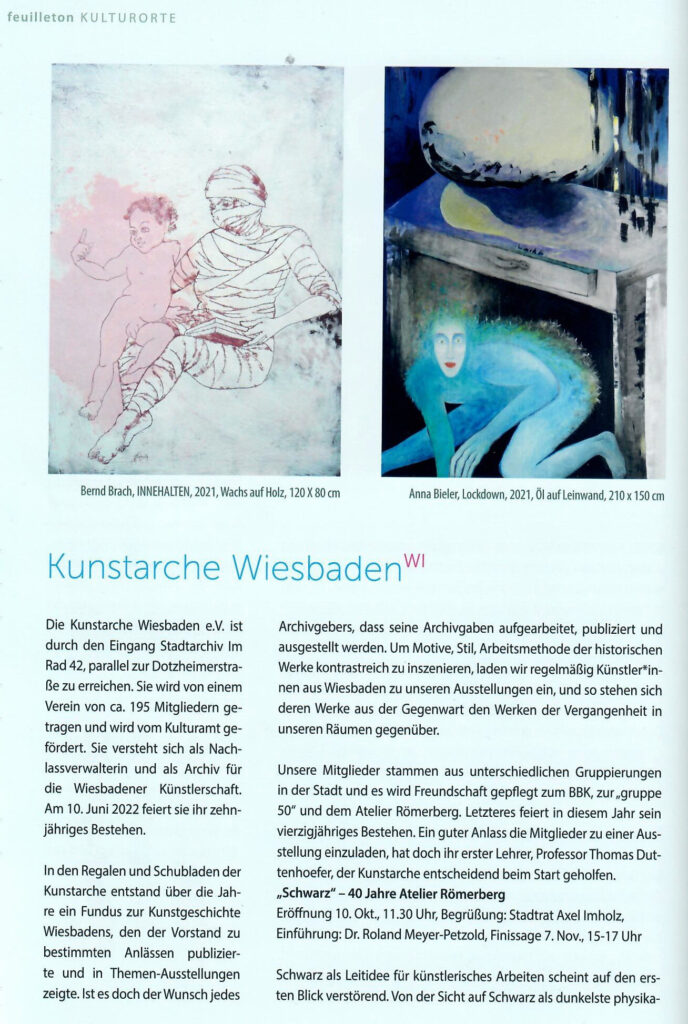
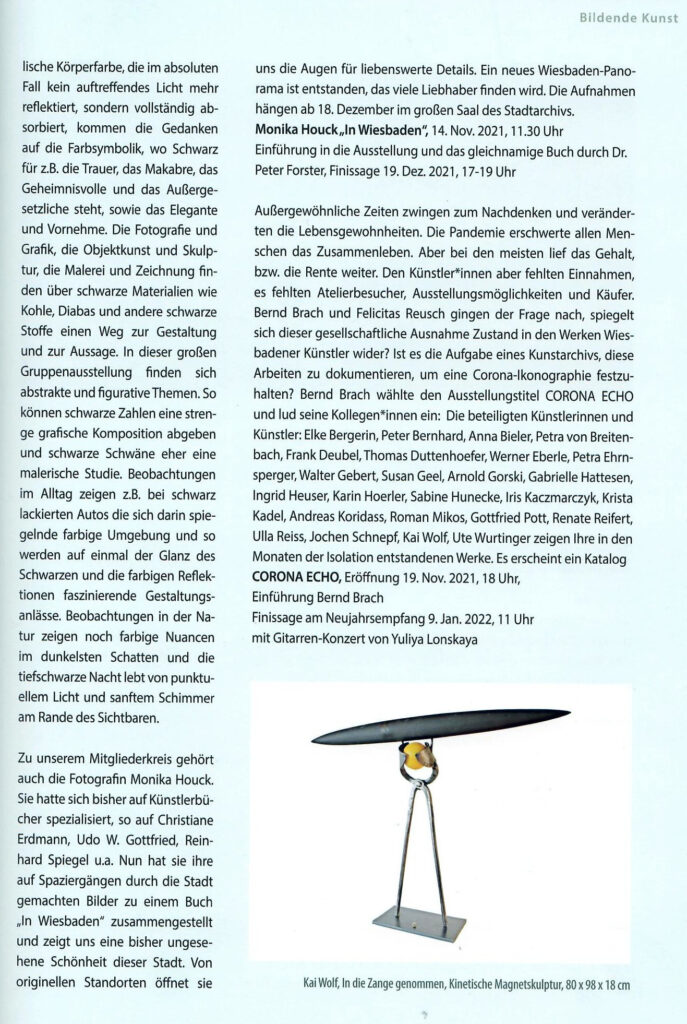
feuilleton, Issue 01, Autumn/Winter 2021
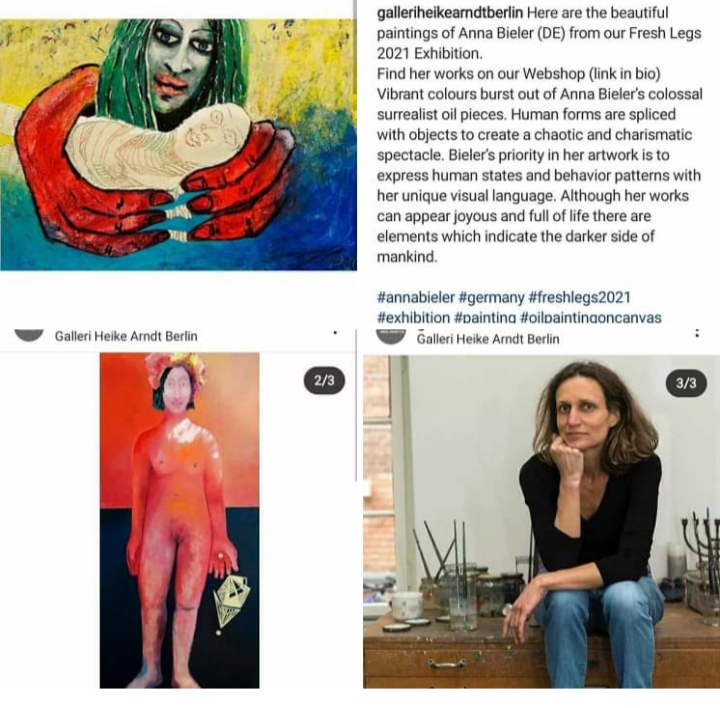
https://l.instagram.com/?u=https%3A%2F%2Finstabio.cc%2Fgalleriheikearndtberlin&kettinge
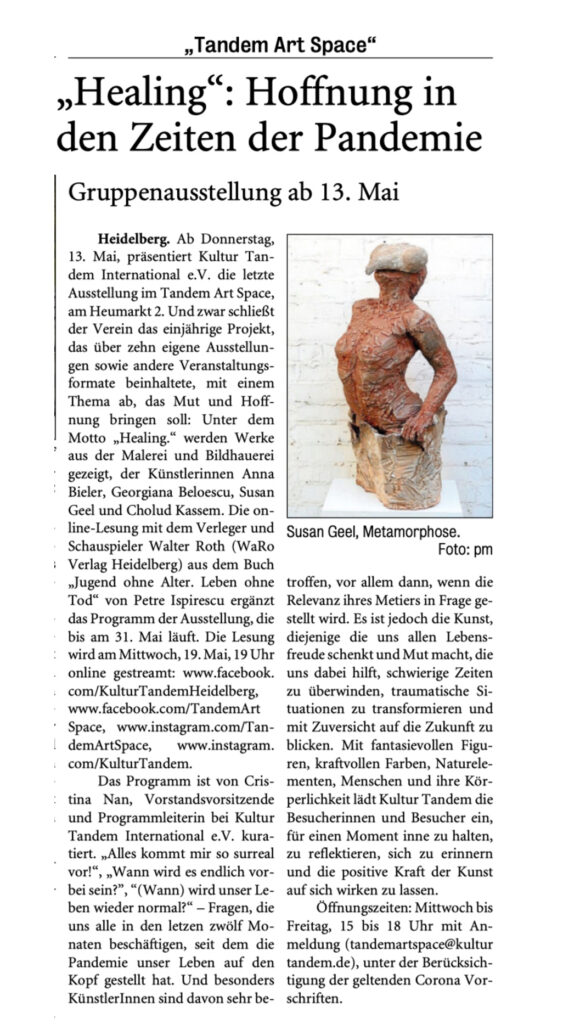
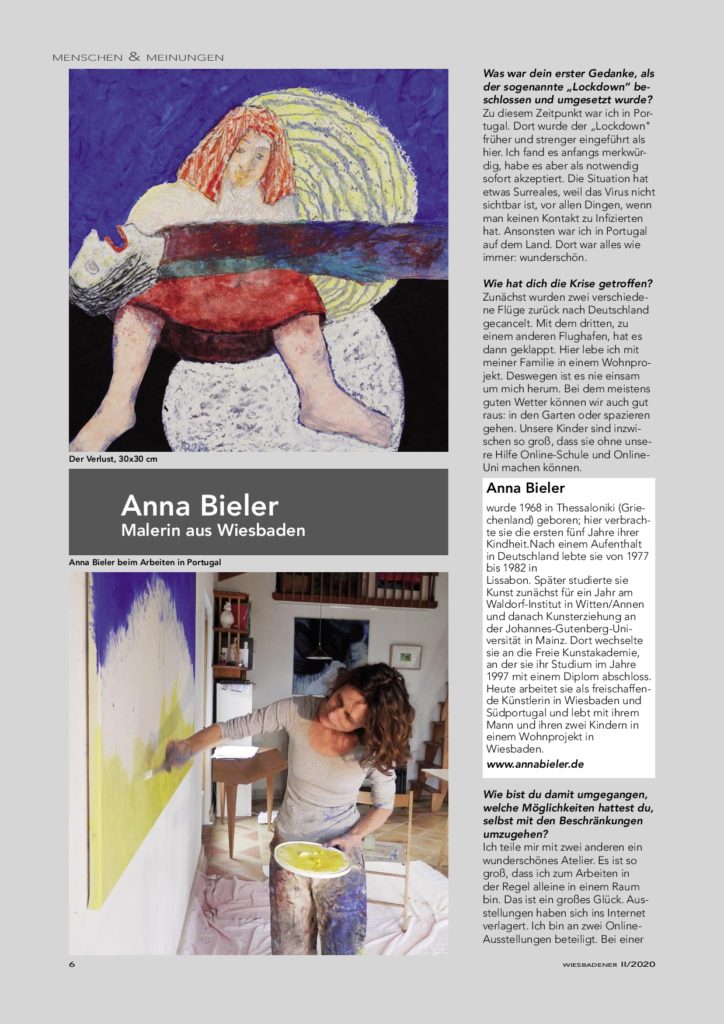
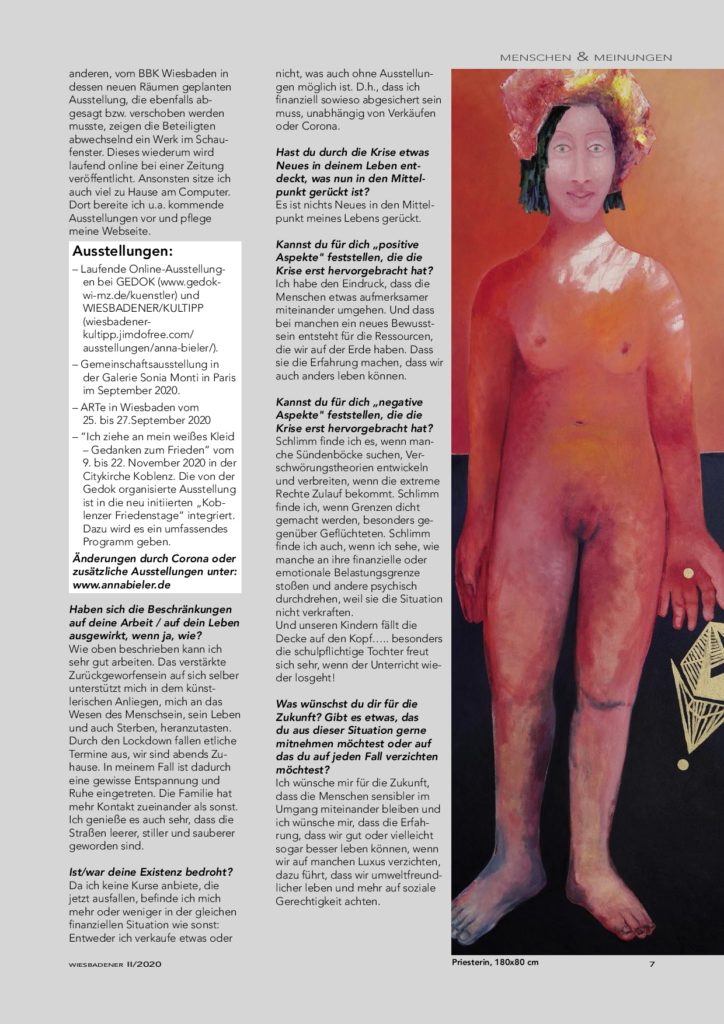
https://www.allgemeine-zeitung.de/artikel_20521005

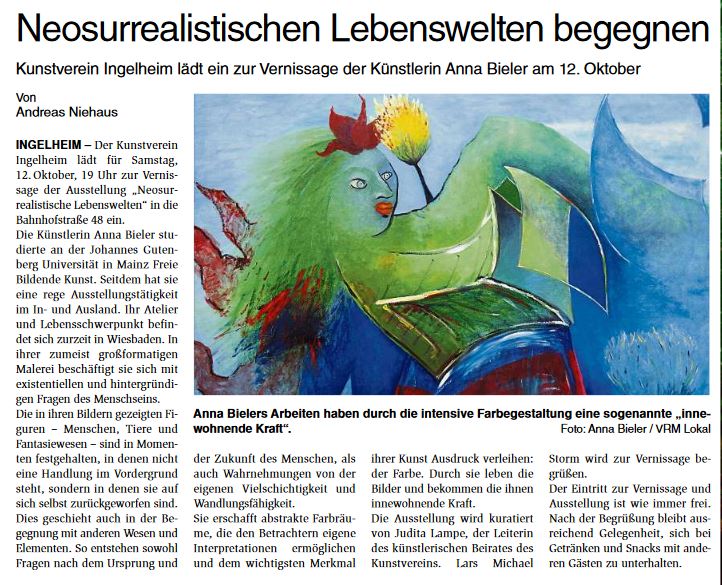
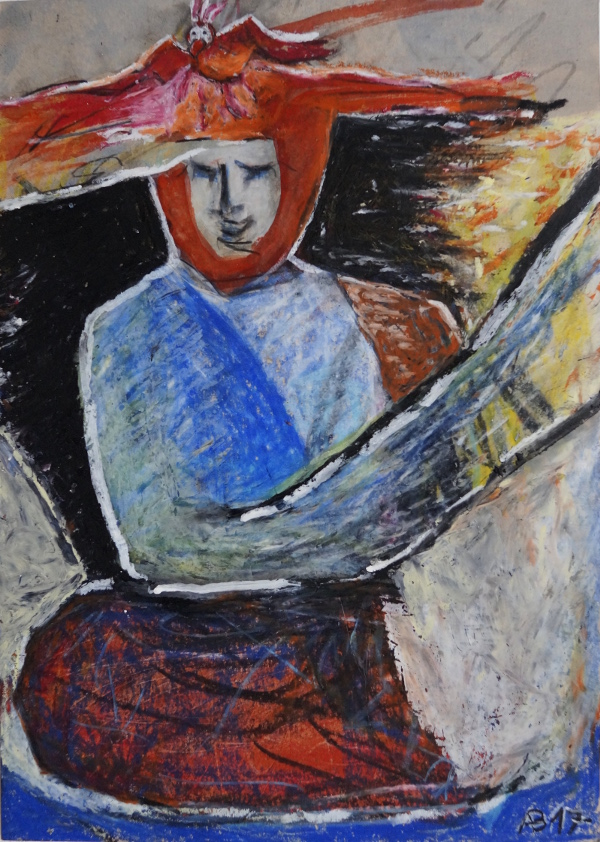
Articles about the exhibition Neosurrealistische Lebenswelten in the Ingelheimer Kunstverein
„Anna Bieler has been distinguished with the Innovarte Prize in the second LaTetra competition, in the section reserved for artists not resident in Cuba. The jury highlights in the small-format work The Shaman Woman, made in mixed technique on paper, its pictorial quality based on a very balanced composition and great chromatic vibration.
The brillant, timeless, and wise female figure seems to be in possession of ancestral tribal secrets…“
Unión Nacional de Escritores y Artistas de Cuba, on 13.12.18
Article by Anja Baumgart-Pietsch about the exhibition STÖRFELDER from 4.4.2019
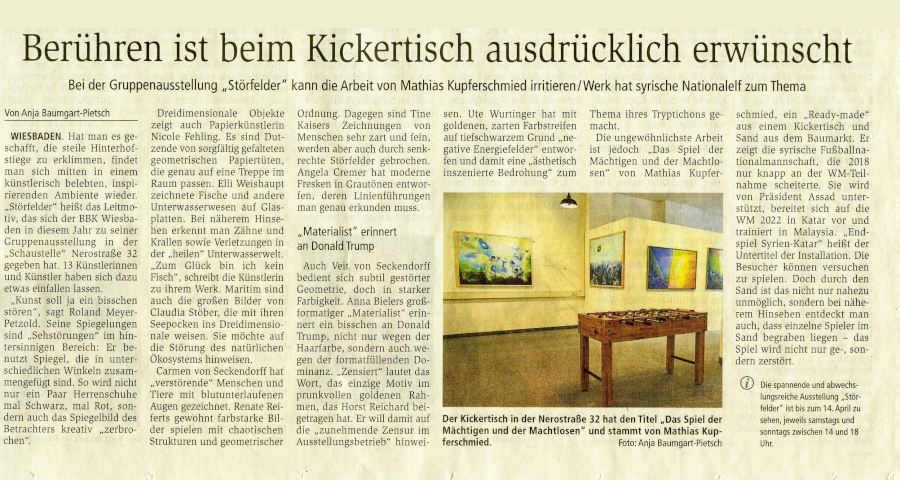
Exposición LA Tetra en la sala Rubén Suárez Quidielo, Mayabeque, Cuba, impresiónes
https://www.youtube.com/watch?v=9BM5S1lLpsE&t=15s
Exposición LaTetra, boletín y entrevistas
https://www.youtube.com/watch?v=xQ11X38dlA0

Wiesbadener III 2018 Artikel Anna Bieler
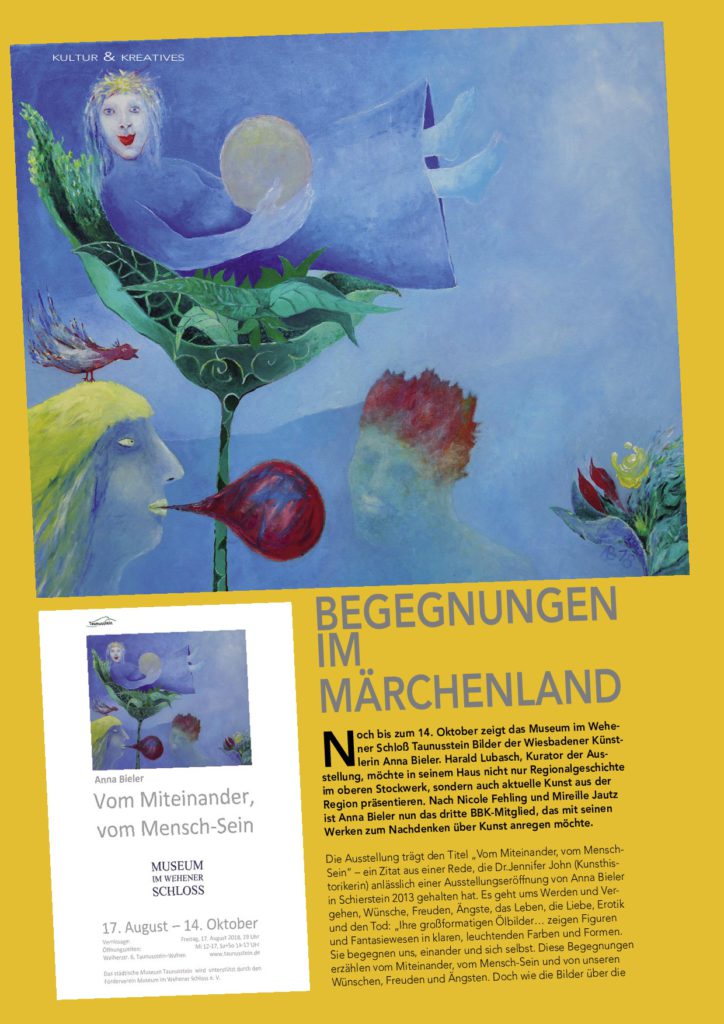
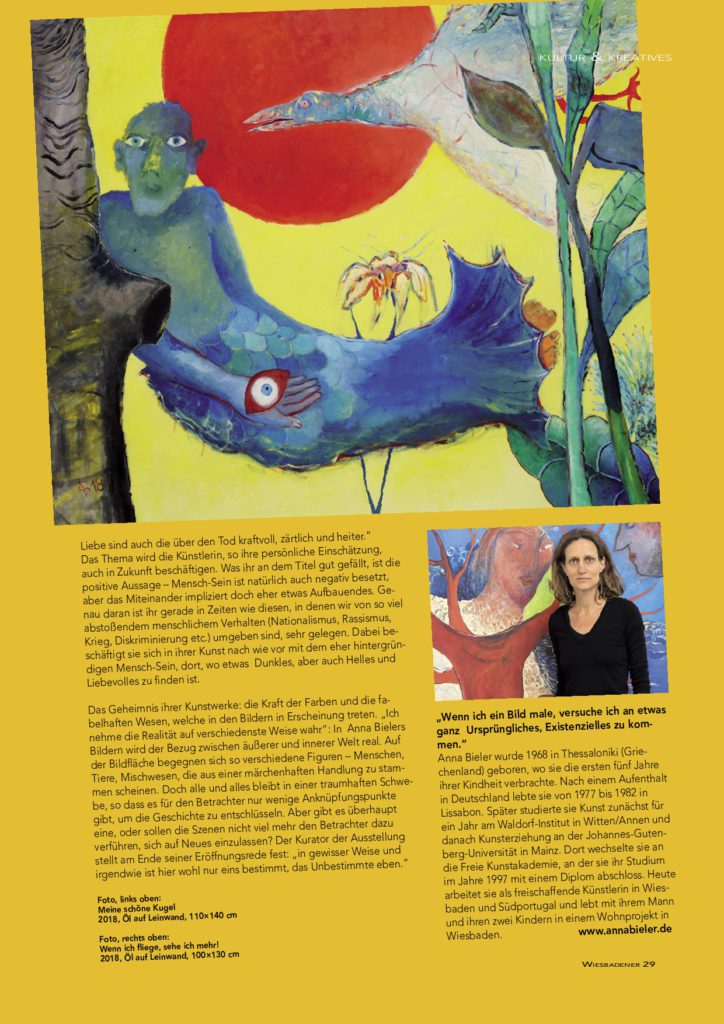
Artikel von Hendrik Jung im Wiesbadener Kurier/Tagblatt
Anna Bieler geht es bei ihren Bildern um menschliche Befindlichkeiten, Verhalten und Zustände
Von Hendrik Jung am 21.08.2018

Anna Bieler bei der Kunstausstellung im Schloss vor einem ihrer Werke. Foto: RMB/Wolfgang Kühner
WEHEN – Eine Berührung an der Wange lässt ein feurig-rotes Wesen entflammen. Ein kleines Mädchen schaukelt hingebungsvoll auf einem Fisch, der in den Ästen eines Baumes hängt. Ein Riese hält einen Fisch mit einem bunten Schuppen-Mosaik sanft in seinen Händen.
„Ich selber denke dabei nie an Geschichten“
Die Arbeiten der Wiesbadener Malerin Anna Bieler, die im Museum im Wehner Schloss in der Reihe Kunst aus der Region gezeigt werden, weisen eine vielgestaltige Bildsprache auf. „Es ist klar, dass die Leute in meinen Bildern Geschichten sehen. Ich selber denke dabei aber nie an Geschichten. Mir geht es immer um menschliche Befindlichkeiten, Verhalten und Zustände“, erläutert die 50-Jährige. „Vom Miteinander, vom Mensch-Sein“ lautet denn auch der Titel der Ausstellung, in der sich großformatige Ölgemälde auf Leinwand mit kleinen Aquarellen auf Papier abwechseln. Letztere sind dabei auf kleinem Raum nicht weniger ausdrucksstark. Ein Gesicht, das durch eine mit Schwarz, Weiß und Blau betonte Augenpartie maskenhaft wirkt, erscheint mit mal gekräuseltem, mal kubistisch dargestelltem Haupthaar ausgesprochen wild, blickt dem Betrachter aber mit freundlichem Lächeln entgegen.
Unter den Arbeiten, die von stark gezeichneten Charakteren, oft fantasievoll-fabelhaften Mischwesen bevölkert sind, fällt eine sehr aus dem Rahmen. Bei dem Bild mit dem Titel „Tod im Meer“ stehen zwei Quader übereinander vor einer Kulisse aus einer großen gelben Scheibe auf rotem Grund sowie ultramarinem Blau. Darunter ist schemenhaft eine zu einer Kugel zusammengerollte, menschliche Gestalt eingeritzt. Ein Motiv, das über das Schicksal von Flüchtenden, die im Meer ertrinken, hinausweisen soll. „Die Quader stehen für die Last des Materiellen, der Kreis für den Geist. Politisch zu sein, passiert anderswo, bei Demonstrationen auf der Straße. In der Kunst aber sehe ich es nicht als meine Aufgabe, politisch zu sein“, verdeutlicht Anna Bieler. Vielmehr liege ihr sehr daran, Positives in die Welt zu senden. Das kann ein freundlich-blaues Wesen sein, das glücklich mit einer großen Kugel in den Händen in einem mit Blättern ausgepolsterten Pflanzenkelch ruht. Das kann ein Geschöpf mit langen Haaren sein, das wie in einer Yoga-Asana mit nach oben gestrecktem Kopf am Strand liegt, sodass die Brandung und der Rücken die gleiche wellenförmige Krümmung aufweisen. Das kann aber auch ein hagerer, schwarz gekleideter Punker sein, neben dem ein voluminöser Geist schwebt, der in einen leuchtenden Anzug mit psychedelischer Musterung gewandet ist und schmunzelnd auf ihn hinabschaut. Mehrdeutig ist das Aquarell mit dem Titel „Sepp und sein Vogel“. Gleich zwei gefiederte Wesen lassen sich darauf ausmachen. Jedoch ist der Blick der menschlichen Figur mit derartiger Intensität ins Leere gerichtet, dass der Titel auch im übertragenen Sinn gemeint sein könnte. Auf jeden Fall bietet auch diese Arbeit einen idealen Auslöser dafür, aus dem Betrachten des Motivs heraus gedanklich eigene Geschichten zu entwickeln.
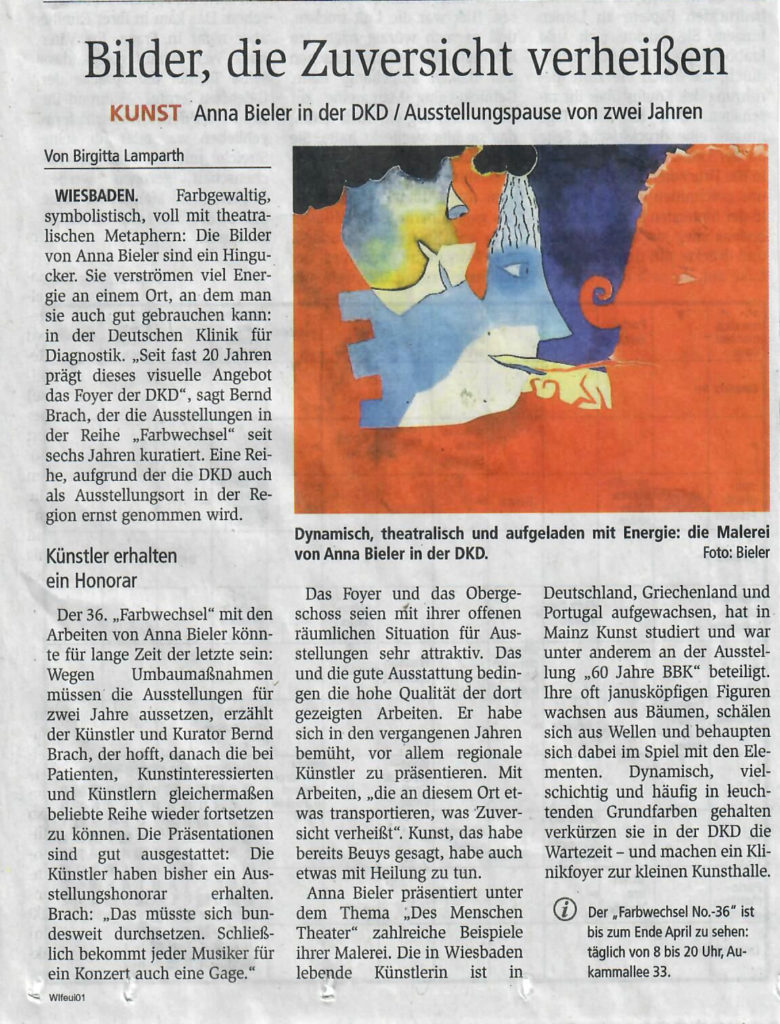
Wiesbadener IV, 2016: Artikel “Des Menschen Theater”
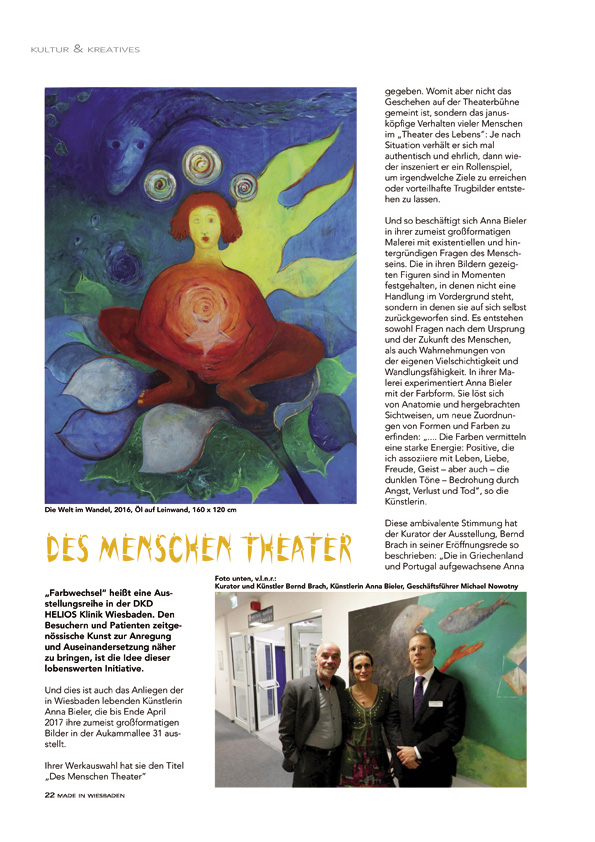
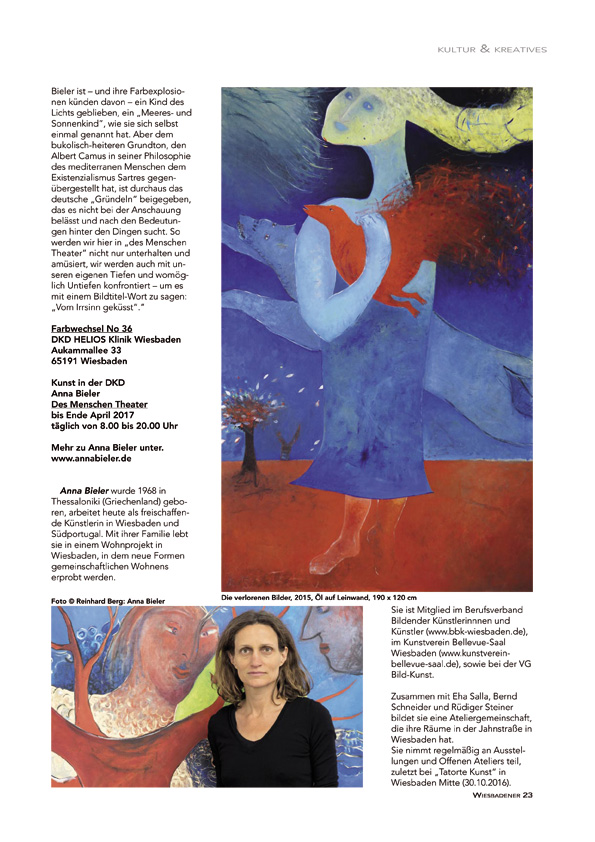
Pressespiegel tatorte Kunst 2016


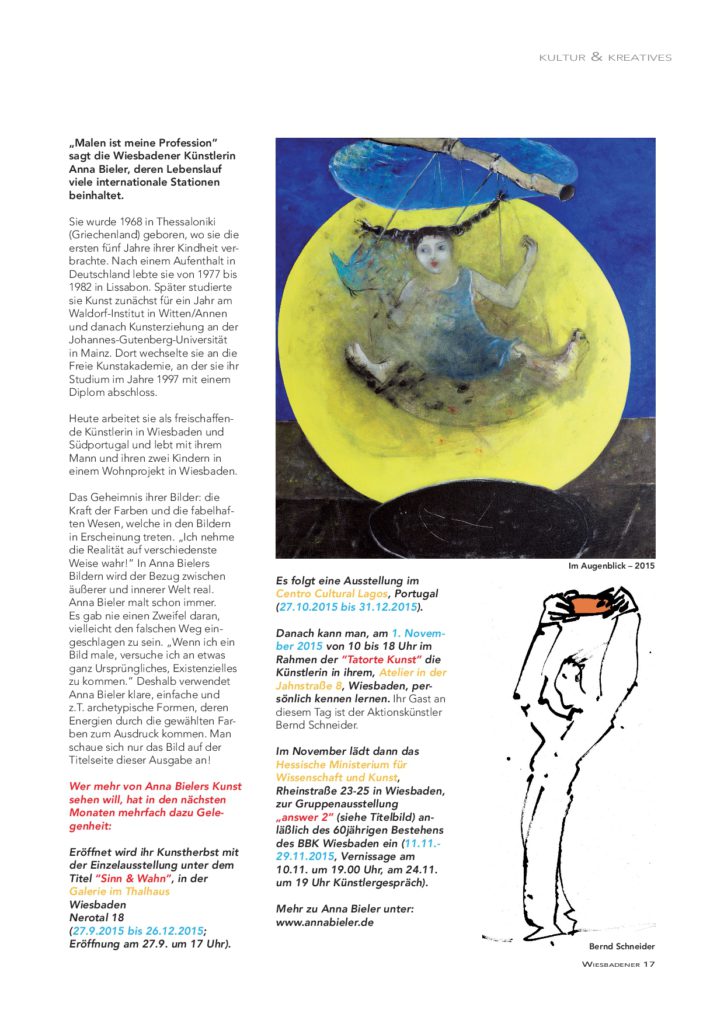 Wiesbadener III, 2015
Wiesbadener III, 201560 Years BBK in Wiesbaden

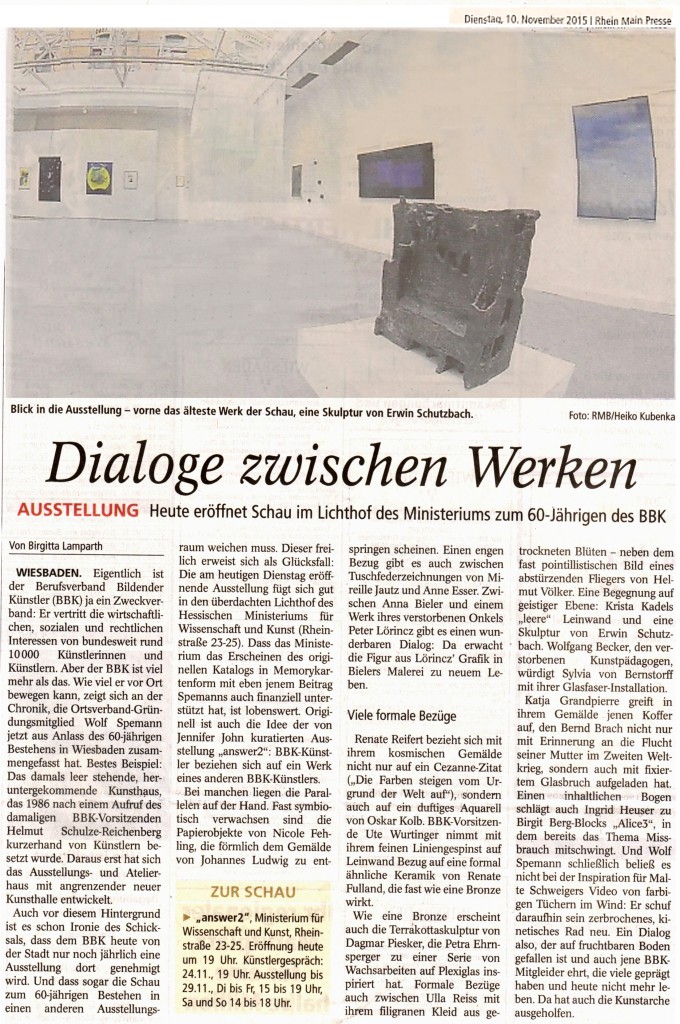

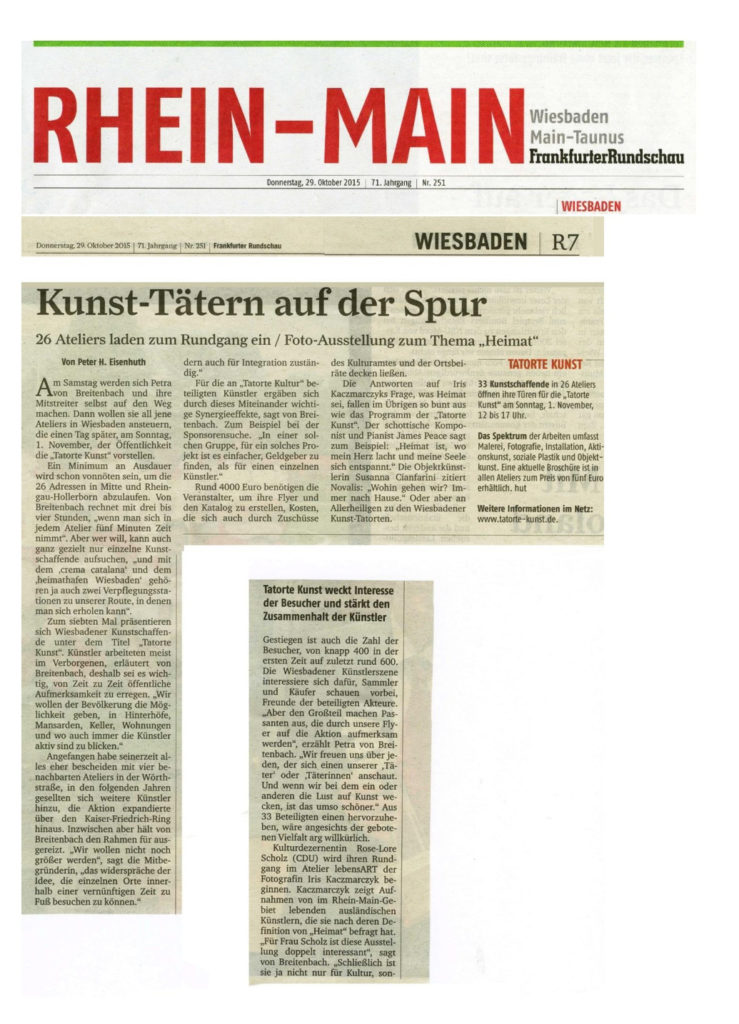
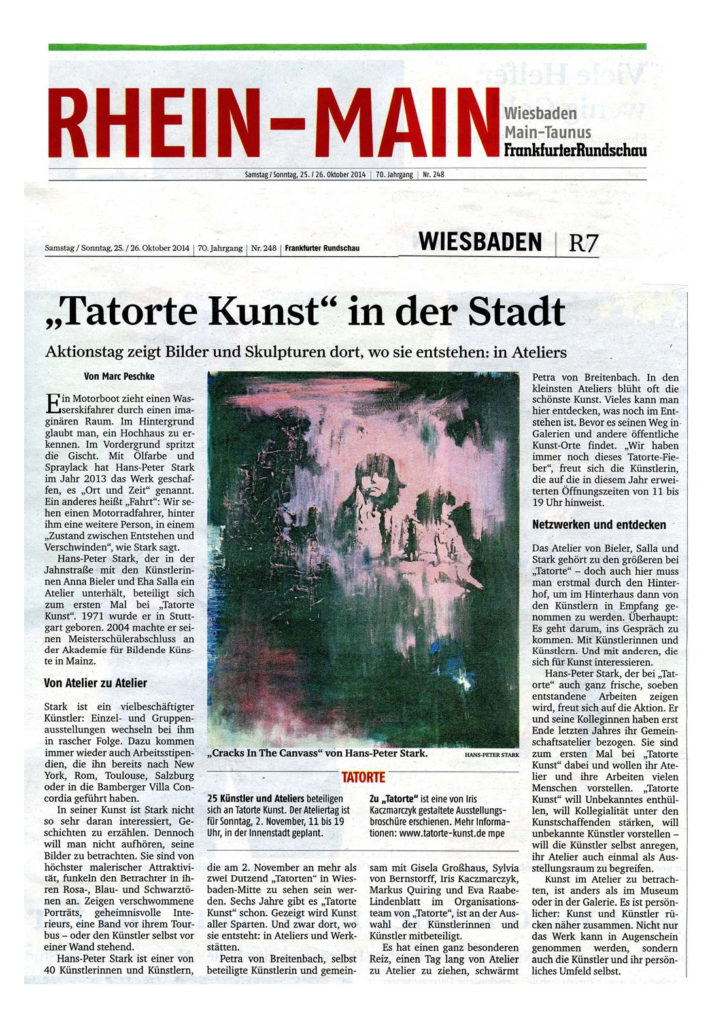
Wiesbadener I, 2013
Bildübergabe Palliativstation
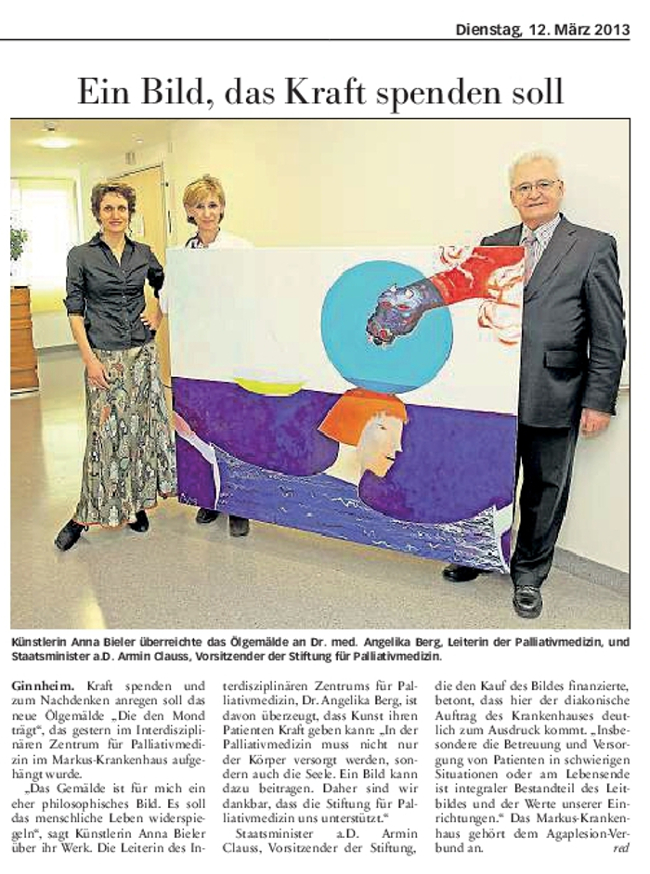
Wiesbadener I 2009 “Colour is Energy”
Translation:
Colour is Energy
Anna Bieler – an artist from Wiesbaden
“She wants to create paintings that need no explanation. At the same time she lets us stand in front of pictures in which quite obviously a story is inherent …”. This excerpt of Siegfried Röth’s speech, delivered in January 2008 during the opening of the exhibition “NEUN im 9” at the studio neun in Mainz, reveals a great deal about the attraction of Anna Bieler’s paintings.
Indeed, at first glance they need no explanation – we see them and feel them! We do not need an explanation – in most cases the story that is inherent is evident to the viewer. It can be clearly felt and perhaps, even surely, each viewer is being told his own story. And perhaps, or rather certainly, this is the reason for the appeal of Anna Bieler’s paintings.
“At the age of 3, everything was clear to her.”
Anna Bieler, born in Thessaloniki (Greece) in 1968, spent there five years of her childhood, then had an interim stay in Germany and afterwards, from 1977 until 1982, lived near Lisbon (Portugal) together with her parents and her brother.
The return to Germany was rather a shock for her. After the inspiration conveyed by the internationality of the German School in Portugal, the return to a school in a small German town was associated with much restriction and with internal and external conflicts. Reaching puberty did not really ease this situation.
Anna Bieler who feels herself to be German without a German homeland (“I do not feel at home in Germany as much as I do in the south and at the sea”) refused to conform to the narrow-mindedness of the small town, but despite these problems she successfully passed her A-levels and determinedly pursued her way – her way as an artist. But this she had never questioned.
“At the age of 3, everything was clear to her”, her father writes about Anna, the child that at an early age challenged her parents in her self-confident and bold way. As far as art was concerned, everything was clear to Anna when she was very young. A lot of things need some more time for decision-making, but with respect to art it was clear to her from the very beginning that this was exactly what she wanted to do.
“About contents and colour I know by intuition. But I have to struggle for the form I give to them.”
In her speech of May 1999, Wilma-Maria Estelmann quotes Anna Bieler with the words: “About contents and colour I know by intuition. But I have to struggle for the form I give to them.” I ask her if it still is like this – even 10 years after her statement.
“It probably still holds true, more or less. But today I would rather call it not “struggle” but “play”, she says and continues: “For each picture, there is only one form that works. And it is necessary to find this very form. This is a part of painting, and if I did not enjoy it I wouldn’t do it. Owing to the painting experience I have been collecting over the years it becomes increasingly easier for me to find the right form.”
In her pictures, Anna Bieler does not paint political subjects. This is a very deliberate decision. “I do not want to show the world as it can be seen by everybody, anyway”.
“For each picture, there is only one form that works. And it is necessary to find this very form.”
Sometimes several encounters with Anna Bieler’s paintings are necessary. Perhaps the situation of the painting must match with the situation of the viewer, and perhaps each encounter ascertains and conveys different priorities.
What remains is the secret, the picture behind the painting, the power of the colours, the marvellous creatures!
“I perceive reality in very different ways.” In Anna Bieler’s paintings, the relationship between external and internal world becomes real.
Anna Bieler has been painting all her life. She never had doubts that perhaps she had chosen the wrong path of life. “I haven’t ONLY painted, though, I had and I have plenty of other interests, and painting is my “work” – my profession”.
“Clarity and structure are important for my life.”
Together with her husband and two children she lives in an alternative living project in the middle of Wiesbaden. To get to her “work” she crosses the Rhine, for her workplace is the studio neun in Mainz. This separation between her two lives is an important aspect for Anna Bieler.
Living in the alternative living project in Wiesbaden certainly offers advantages for the external (daily) world, but for her work it does not play a major role.
“I perceive reality in many different ways!”
The distance between her professional and her private life is significant for her. “For me it is important to leave the house and not to feel myself as a housewife, but as an artist”. On the other hand, she enjoys the advantages that both cities offer – each in its particular way. Living in Wiesbaden and working in Mainz – for the artist Anna Bieler this opens up new opportunities to be present with her works. “I think it is enriching to commute between both cities and to exploit their advantages and their different art and cultural scenes.”
“When I paint a picture, I try to achieve something very original, very existential.”
For Anna Bieler the people are important whom she meets her and the way they approach her, not so much the place where the encounter happens.
When she paints a picture, her everyday life does not play a role. “When I paint a picture, I try to achieve something very original, very existential.”
Therefore Anna Bielder uses clear, simple and partly archetypal forms that obtain their expression through the chosen colours. “The spiritual world manifests itself in the colours – through the energy of the colours. That is why I use predominantly pure colours and a lot of white.”
Paintings of Anna Bieler can be seen:
Galerie im Anderswo, Blücherstr. 17, Wiesbaden (15.05.-03.07.09)
Lange Nacht der Museen (Long Night of Museums) in Mainz, Atelier neun, Heidelbergerfaßgasse 18 (06.06.2009)
Open Studios in the West End of Wiesbaden (20./21.06.2009)
More information about Anna Bieler, her paintings and her exhibitions may be found under www.annabieler.de.
Anna Bieler in Schlangenbad
Clarity is the dominating feature in the gallery “Kommunale Galerie” in Schlangenbad. This is due to Anna Bieler’s art which is on display there. The mostly large-surface pictures of the painter, who was born in 1968, impart a cheerfulness through their primary colors that are brightened to enhance their power of shining. […]
Teeming life, development and growing dominate the painting world of the artist who works in Portugal and in Germany. Subliminally, as a tiny sting only, every now and then a counterpart creeps in. Hidden behind the mask, “in the paradise” another side, the dark side, becomes evident. It does never come to power, though. It is present. It plays its role and stays at the side of the newly created human being that is still naive. The unconscious element does not disconcert the viewer, on the contrary: it balances the opposites. In her collage-like painting art Bieler knows how to join the contradictions into a glow.
Wiesbadener Kurier, 6 March 2007
Crocheted anemones in front of the door to Paradise – Exhibition of the artist group “Atelier Neun”
[…] After so much black painting in the studios, the charming-enchanting oil paintings of Anna Bieler move the world again under a cheerful, yellow-glowing paradise sun. Snake and fish are growing towards each other out of this blue-red subdivided Garden of Eden that is entwined by fanciful fauns, until they seem to lie in the perpendicular. But an impudent snapping in the roots anticipates – as in the jungle paintings of Henri Rousseau – that it could be already past twelve o’clock in the jungle. […]
Allgemeine Zeitung, Mainz, 22 November 2005
Double-exhibition with much emotion
At all events, her works show a self-reliance and authenticity which impress at the first glance. Dull blended colors are banished, and clear and strong colors are prevailing. Anna Bieler abstracts the world of forms that is still perceptible, in particular the female world. Love, pregnancy, motherhood and never-ending care are woven into the structure of her pictures that seem to be thoroughly conceived. Silhouette-like figures might play together, like in a love act, cupules might roll against each other, waves might roll through her work. No matter which subject Anna Bieler chooses, this young artist pervades her work with a warmness and richness of forms and colors that cannot be expressed in words.
ESA (Entdecken Sie Algarve – Discover the Algarve), April 2005
Pictures take you to an enchanting world
Two features seem to characterize the pictures of Anna Bieler that are presently on display in the gallery Mennonitenkirche: On the one hand, wideness and cheeriness, and on the other hand an abstracting world of forms. Above all, the young painter draws on luscious colors. The pictures are dominated by a few unbroken, brilliant and bright colors – often in glowing dark red, vermilion or gold-orange, contrasted by cold blue and violet hues . Nothing is arbitrary in Anna Bieler’s pictures. A large part of making of the artist’s new work is dedicated to the mental confrontation with her work itself – something that for her is synonymous with the purely technical skill. […]
The world is portrayed in its sensuousness, and the strong colors appeal to our feelings. It is the color of everything surrounding mankind. The colors of the sky and the water, of the fire and the air, of the plants and the animals. The striking pictures of Anna Bieler can be seen until 30 June. […]
Rhein-Zeitung Neuwied, 31 May 2002
The world as a play of colors
[…] Wilma-Maria Estelmann started her introduction into the art of the painter with the poem of Ingeborg Bachmann “Erklär mir, Liebe” (“Explain to me, love”). “ This poem came into my mind when I first looked at these pictures. They come from a dark-light depth, like the verbal art of the poet who is able to express darkness.” […] The world is presented in its sensuousness, sometimes in a subtle way, sometimes with a provoking clarity, but never sliding into obscenity”, Wilma-Maria Estelmann emphasizes. […]
“What I paint is the soul of mankind, and never did mankind miss anything so much than its soul today”, Anna Bieler tells about her pictures. […]
“Form and color follow the lines of reality and let show through the lines of another reality that will come one day”, as Ingeborg Bachmann wrote in “A day will come”. With these words Estelmann concluded her speech and opened the exhibition. […]
Rhein-Neckar-Zeitung, 3 May 1999
Large forms and strong colors
[…] A contagious pleasure of colors originates indeed from the pictures of the young artist. The viewer cannot get enough of the unique forms. His eyes move to and fro, discover a wave, the wing of a bird, a female breast, an eye, recognize a fish and a sun, a phallus and the petal of a flower. In other pictures a female body may be guessed, or the branches of a tree shaken by the wind. Anna Bielers excellently knows how to grant the viewer freedom for his own interpretation by using abstracted forms and colors. […]
Anna Bieler’s great subject is the human being in its vitality and sensuousness, in its disharmony and contradiction – something that is reflected in her pictures through stylistic incongruities which are used with intention: sketch-like depictions are set next to poster-like portrayals, carefully marked-off parts next to blurred ones, a monochrome field with ultramarine next to darting grimaces in blazing red. “The artist is a master of her profession”, Wilma-Maria Estelmann declares. She continues that Bieler mastered one aspect as well as the other and had found her very own kind of painting which does not necessarily follow the prevalent taste in art. […]
Fränkische Nachrichten, 3 May 1999
Beyond Good and Evil.
Anna Bieler’s pictures reflect the sentiments of the mind “ Colors do not only symbolize energy, they are energy”, the painter Anna Bieler says. […]
Her works, using as preferred colors the pure primary colors red, yellow and blue as well as archetypical symbols such as the bird, the sun, but also the female breast and phallus, show landscapes of the mind that exist beyond good and evil. Her large-surface pictures remind of flags for sensual districts or internal worlds that are no longer marginalized, but obtain the right to develop through the colors. […]
Anna Bieler shows a selection of pictures that captivate through the luminosity of the positive colors and the sensual, sometimes even humorous or playful forming. […]
Kölner Stadtanzeiger, 8 September 1998
Bold little bloke with yellow arms and red ears
How does a “Pril flower man”¹ look like? You have to admit: you don’t know. Anna Bieler knows. The young artist from Hessen paints the bold little bloke with yellow arms, a green head, blue upper body, red ears and genitals. The Pril flower man, that much is certain, is not a homunculus, and the environment surrounding him is almost as colorful as he himself. The figure almost seems to merge with nature. […]
Anna Bieler interprets the world as a play of colors. Her chromatics prefers yellow, red and blue. The structure of her pictures in oil and watercolor keep their determined contours, and she avoids the soft sliding of the color hues. The artist, apart from her delight in the flush of colors, illustrates the human being with its sexuality. […]
The human sensuousness comes along with a trace of disharmony. The often abrupt changes in color reflect the inconsistency of human behavior. Humans and animals are transformed into abstract bodies, and the power of the colors breathes mythical energy of life into them. […]
¹ Pril is a German dishwashing liquid
Bergische Landeszeitung, 8 September 1998
